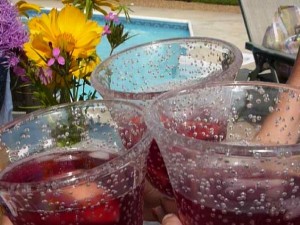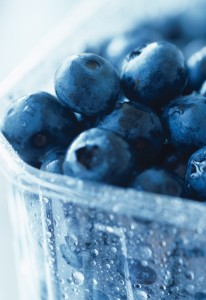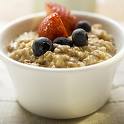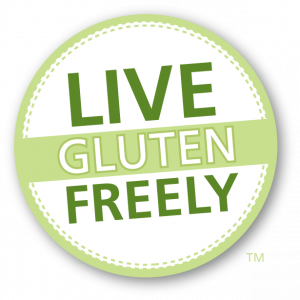Summer Meals: It’s time for Fruits & Veggies… Fresh and Exciting!
Sunday, July 25th, 2010 Summer is a time when fruits and veggies are in abundance. Backyard gardens are bursting at the seams with the bounty of the good earth, with a new harvest arriving each day. Fruit and vegetables are falling off the vines, ripening to perfection and begging to be picked.
Summer is a time when fruits and veggies are in abundance. Backyard gardens are bursting at the seams with the bounty of the good earth, with a new harvest arriving each day. Fruit and vegetables are falling off the vines, ripening to perfection and begging to be picked.
And every day as I am filling up my garden basket with more and more lettuce, tomatoes, blueberries, blackberries, green beans, zucchini and squash (plus more!) I laugh to myself. What seemed like a ridiculously small and “definitely not big enough” garden plot last April is now producing enough fruit and veggies to feed a small, but well-fed and health-conscious army.
Not a bad problem for a super-frugal gluten and allergen free gal like me to have.
This abundance of fruits and veggies got me thinking of new ways to incorporate the rewards of my garden into every meal. My mission? To eat and enjoy healthy gluten and allergen free dishes made with as many fruits and vegetables as possible, every single time I prepare a meal, without getting tired of the same old thing day after day.
This mission means that I have to start thinking beyond a boring tossed salad, ho-hum rabbit food and leafy greens drenched in salad dressing. Just like the Kool and the Gang song of the 80’s, I need to makes sure that my summer produce is not only fresh… but also exciting. (And yes… that song is now stuck in my head every time I go into my garden!).
Here are some of my ideas on ways to incorporate and enjoy summer fruits and vegetables throughout the season, while keeping things fresh, exciting and so inviting to me:
Enjoy local flavor: Don’t have your own garden? Visit a local farm stand or farmers market instead. One visit will get you hook on just-picked produce and healthier eating!
Get fruity: Get crazy with your fruits! Toss some sliced peaches on top of a dinner salad; Add a sprinkle of berries to your gluten-free cereal; Make a fruit-smoothie for breakfast… better yet make two, freeze one and enjoy it for an after dinner dessert.
Spice it up: Use fresh herbs to season and flavor your food. A sprinkle of chopped cilantro gives a boring chicken breast a southwestern flair; Rosemary sprigs chopped and tossed with olive oil and potatoes gives instant sophistication and complexity to an unexpected side dish. Fresh herbs are often the secret ingredient some dishes crave. Think fresh herbs instead of salt and pepper to healthily season any gluten and allergen free recipe.
Beyond butter: Those with a dairy allergy or intolerance need to skip butter altogether, but even those that can indulge, should look beyond the butter dish when in comes to seasoning vegetables. Try spraying olive oil or balsamic dressing on fresh steamed veggies. Better yet, try white balsamic vinegar instead of regular balsamic vinegar to enjoy a milder and cleaner flavor.
Build a salad with a base of lower calorie options and work your way up: If you want to enjoy tons and tons of fresh vegetables, make sure that you base the bulk of your meals around the lowest calorie ingredients, and then sparingly incorporate the higher calorie add-ins. Some example? Build a salad using fresh lettuce, tomatoes, cucumber, peppers and other fresh picked produce, then sprinkle with lactose-free cheeses, nuts (if nut allergies are not an issue), and gluten-free croutons; or, steam some fresh picked zucchini and summer squash, top with chopped basil and a dusting of Parmesan cheese.
Make it a meal deal: Fresh produce and fruit can be the main course of any meal, if you add in a bit of protein to tie-it all together. Some options to add to your steamed dinner veggie platter include meat, seafood, cheeses and beans.
It’s in the presentation: All salads don’t have to be tossed. All vegetables don’t have to be diced and boiled before serving. Try serving your salad “salad-bar style” on a large platter – let your family pick-and-choose the topping they want on their own individual salads; Use the grill to cook a zucchini that is halved lengthwise and brushed with olive oil, cracked pepper and fresh herbs.
Get creative: Use fresh seasonal vegetables in unexpected ways. In a veggie omelet for a healthy breakfast, or even dinner; chop up tons of summer vegetables for a wide assortment of toppings on a taco salad.
 any alcoholic beverages that are gluten-free?
any alcoholic beverages that are gluten-free? When I was a little girl, my sisters and I would pile into the car with Mom and drive to the Southeastern shore of Massachusetts to go blueberry picking. The sun was always hot, the air was often steamy and the dragonflies were buzzing.
When I was a little girl, my sisters and I would pile into the car with Mom and drive to the Southeastern shore of Massachusetts to go blueberry picking. The sun was always hot, the air was often steamy and the dragonflies were buzzing. Some people say that eating gluten and allergen-free can be bland and boring. If you think this is true, try spicing up both your recipes, and your life, with fresh herbs.
Some people say that eating gluten and allergen-free can be bland and boring. If you think this is true, try spicing up both your recipes, and your life, with fresh herbs. One of the things that I, and many others, miss the most after being diagnosed with celiac disease or food allergens is the convenience and affordability of quick and easy Chinese Take-Out.
One of the things that I, and many others, miss the most after being diagnosed with celiac disease or food allergens is the convenience and affordability of quick and easy Chinese Take-Out. Question: Are oats allowed on a gluten-free diet?
Question: Are oats allowed on a gluten-free diet? 
 cookie cutters, cut out cookies and place on an ungreased cookie sheet about ½” apart from each other.
cookie cutters, cut out cookies and place on an ungreased cookie sheet about ½” apart from each other. Place a bit of the icing in each bowl and mix in food coloring to make the desired colors for the cookies you are frosting. (Note: the more colors you mix up the more creative you will get!)
Place a bit of the icing in each bowl and mix in food coloring to make the desired colors for the cookies you are frosting. (Note: the more colors you mix up the more creative you will get!) er service line been closed and your questions have been left unanswered?
er service line been closed and your questions have been left unanswered?